Hotspot areas of risky sexual behaviour and associated factors in Ethiopia: Further spatial and mixed effect analysis of Ethiopian demographic health survey
- PMID: 38820433
- PMCID: PMC11142568
- DOI: 10.1371/journal.pone.0303574
Hotspot areas of risky sexual behaviour and associated factors in Ethiopia: Further spatial and mixed effect analysis of Ethiopian demographic health survey
Abstract
Introduction: Sexual behaviour needs to take a central position in the heart of public health policy makers and researchers. This is important in view of its association with Sexually Transmitted Infections (STIs), including HIV. Though the prevalence of HIV/AIDS is declining in Ethiopia, the country is still one of the hardest hit in the continent of Africa. Hence, this study was aimed at identifying hot spot areas and associated factors of risky sexual behavior (RSB). This would be vital for more targeted interventions which can produce a sexually healthy community in Ethiopia.
Methods: In this study, a cross-sectional survey study design was employed. A further analysis of the 2016 Ethiopia Demographic and Health Survey data was done on a total weighted sample of 10,518 women and men age 15-49 years. ArcGIS version 10.7 and Kuldorff's SaTScan version 9.6 software were used for spatial analysis. Global Moran's I statistic was employed to test the spatial autocorrelation, and Getis-Ord Gi* as well as Bernoulli-based purely spatial scan statistics were used to detect significant spatial clusters of RSB. Mixed effect multivariable logistic regression model was fitted to identify predictors and variables with a p-value ≤0.05 were considered as statistically significant.
Result: The study subjects who had RSB were found to account about 10.2% (95% CI: 9.64%, 10.81%) of the population, and spatial clustering of RSB was observed (Moran's I = 0.82, p-value = 0.001). Significant hot spot areas of RSB were observed in Gambela, Addis Ababa and Dire Dawa. The primary and secondary SaTScan clusters were detected in Addis Ababa (RR = 3.26, LLR = 111.59, P<0.01), and almost the entire Gambela (RR = 2.95, LLR = 56.45, P<0.01) respectively. Age, literacy level, smoking status, ever heard of HIV/AIDS, residence and region were found to be significant predictors of RSB.
Conclusion: In this study, spatial clustering of risky sexual behaviour was observed in Ethiopia, and hot spot clusters were detected in Addis Ababa, Dire Dawa and Gambela regions. Therefore, interventions which can mitigate RSB should be designed and implemented in the identified hot spot areas of Ethiopia. Interventions targeting the identified factors could be helpful in controlling the problem.
Copyright: © 2024 Anley et al. This is an open access article distributed under the terms of the Creative Commons Attribution License, which permits unrestricted use, distribution, and reproduction in any medium, provided the original author and source are credited.
Conflict of interest statement
The authors have declared that no competing interests exist.
Figures

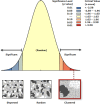
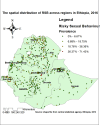
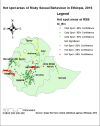
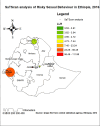
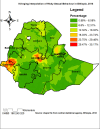
Similar articles
-
Geospatial pattern of HIV seropositivity and its predictors among women in Ethiopia. A spatial and multiscale geographically weighted regression analysis.PLoS One. 2024 Jul 11;19(7):e0306645. doi: 10.1371/journal.pone.0306645. eCollection 2024. PLoS One. 2024. PMID: 38990932 Free PMC article.
-
Spatial variation and geographical weighted regression analysis to explore open defecation practice and its determinants among households in Ethiopia.PLoS One. 2024 Jul 18;19(7):e0307362. doi: 10.1371/journal.pone.0307362. eCollection 2024. PLoS One. 2024. PMID: 39024342 Free PMC article.
-
Hotspots of unimproved sources of drinking water in Ethiopia: mapping and spatial analysis of Ethiopia demographic and health survey Data 2016.BMC Public Health. 2020 Jun 8;20(1):878. doi: 10.1186/s12889-020-08957-2. BMC Public Health. 2020. PMID: 32513128 Free PMC article.
-
Using multilevel models to evaluate the influence of contextual factors on HIV/AIDS, sexually transmitted infections, and risky sexual behavior in sub-Saharan Africa: a systematic review.Ann Epidemiol. 2018 Feb;28(2):119-134. doi: 10.1016/j.annepidem.2017.11.006. Epub 2017 Dec 5. Ann Epidemiol. 2018. PMID: 29439782
-
Supporting Family and Community Investments in Young Children Globally: Workshop in Brief.Washington (DC): National Academies Press (US); 2015 Nov 3. Washington (DC): National Academies Press (US); 2015 Nov 3. PMID: 27336118 Free Books & Documents. Review.
References
-
- Agajie M, Belachew T, Tilahun T, Amentie M: Risky sexual behavior and associated factors among high school youth in Pawe Woreda, Benishangul Gumuz Region. Science Journal of Clinical Medicine 2015, 4(4):67–75.
MeSH terms
LinkOut - more resources
Full Text Sources

